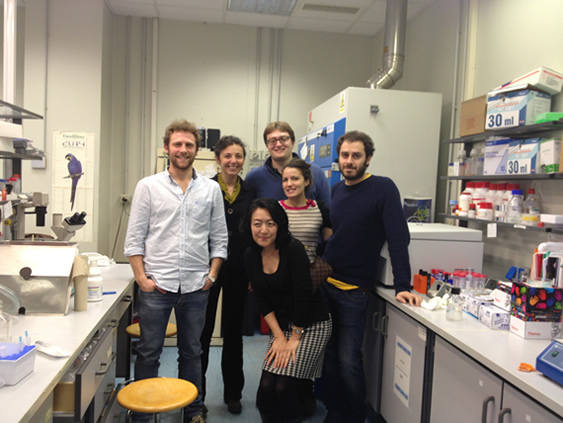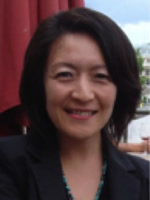Scientific Report
(1) ex vivo producing megakaryocytes and platelets
Platelets are essential for hemostatic plug formation, and platelet transfusions are widely used for patients with severe thrombocytopenia. Donor-dependent, platelet transfusions are, however, associated with practical problems, such as the limited supply due to the short storage life of platelets and the risk of bacterial infection, and serious immune reactions. New strategies for manufacturing megakaryocytes (MKs) and subsequently platelets beginning with non-donor dependent sources may obviate these and other platelet transfusion concerns.
Platelets are released from terminally differentiated MKs. Recently, it has been used to generate enriched populations of MKs using ex vivo differentiation systems. MKs and platelets have been differentiated from hematopoietic stem cells (HSCs), fetal liver cells, embryonic stem (ES) cells, and induced pluripotent stem (iPS) cells. Moreover, we have reported the generation of MKs and functional platelets beginning with subcutaneous adipose tissues and the preadipocyte cell line 3T3-L1. The use of HSCs as the starting material is problematic, however, due to their low capacity for in vitro expansion. For all of these various cell sources of MKs and platelets, yields are insufficient for clinical application. Therefore, the development of new strategies to generate platelets for transfusion is crucial.
(2) Focus on the development of culture system for more efficient production of platelets in vitro
Our research group has worked on the development of culture system to generate platelets efficiently [1-5]. As a culture system for the MK and platelet differentiation, Balduini A and colleagues developed the system that has the spatial reconstruction of the bone marrow environment [6]. They showed that MKs migrate toward the vascular niche, extend proplatelets, and release functional platelets into vascular tubes. In any published studies of in vitro platelet production, the number of platelets per MK was similarly low [7], so the 3D system might be useful to obtain a large number of platelets in in vitro culture. In this study, I was planning to test the MK migration tubes coated by candidate reagents in relation to bone marrow environment in the 3D system for more efficient production of platelets in vitro. There are experts for bone marrow niche in the home laboratory, and the applicant has studied megakaryopoiesis and thrombopoiesis using an in vitro culture system [1-5, 8]. Regarding the host laboratory, Dr. Balduini has worked on the development of in vitro culture system and the platelet biology. Development of a new culture system for in vitro differentiation into MKs and platelets will be expected by the knowledge in the host and home laboratory in this study. I watched to prepare the 3D system in Balduini’s lab, and her lab members explained its system using ex vivo generated MKs. The lab member and I discussed about the role of bone marrow niche in megakaryopoiesis and subsequent thrombopoiesis. Based on the experience in Balduini’s lab in January 2014, we are developing a culture system for more efficient production of platelets in vitro, using commercial available cells, human bone marrow CD34-positice cells and human subcutaneous preadioicytes.
References
- 1. Matsubara Y, Saito E, Suzuki H, Watanabe N, Murata M, Ikeda Y: Generation of megakaryocytes and platelets from human subcutaneous adipose tissues. Biochem. Biophys. Res. Commun. 378: 716-720, 2009
- 2. Matsubara Y, Suzuki H, Ikeda Y, Murata M: Generation of megakaryocytes and platelets from preadipocyte cell line 3T3-L1, but not the parent cell line 3T3, in vitro. Biochem. Biophys. Res. Commun. 402: 796-800, 2010
- 3. Matsubara Y, Murata M, Ikeda Y. Culture of megakaryocytes and platelets from subcutaneous adipose tissue and a preadipocyte cell line. Methods Mol Biol. 788: 249-58, 2012.
- 4. Ono Y, Wang Y, Suzuki H, Okamoto S, Ikeda Y, Murata M, Poncz M, Matsubara Y. Induction of functional platelets from mouse and human fibroblasts by p45NF-E2/Maf. Blood 120 (18): 3812-21, 2012.
- 5. Matsubara Y, Ono Y, Suzuki H, Arai F, Suda T, Murata M, Ikeda Y. OP9 bone marrow stromal cells differentiate into megakaryocytes and platelets. Plos One 8 (3): e58123, 2013. 8 (3): e58123, 2013.
- 6. Pallotta I, Lovett M, Kaplan DL, Balduini A. Three-dimensional system for the in vitro study of megakaryocytes and functional platelet production using silk-based vascular tubes. Tissue Eng Part C Methods. 17(12): 1223-32, 2011.
- 7. Lambert MP, Sullivan SK, Fuentes R, French DL, Poncz M. Challenges and promises for the development of donor-independent platelet transfusions. Blood. 121(17): 3319-24, 2013
- 8. Arai F, Hosokawa K, Toyama H, Matsumoto Y, Suda T. Role of N-cadherin in the regulation of hematopoietic stem cells in the bone marrow niche. Ann N Y Acad Sci. 1266: 72-7, 2013
(3) Acknowledgement
I would like to thank Dr. Alexssandra Balduini and all members of her lab. Also, I would like to thank all members of EHA and JSH.


